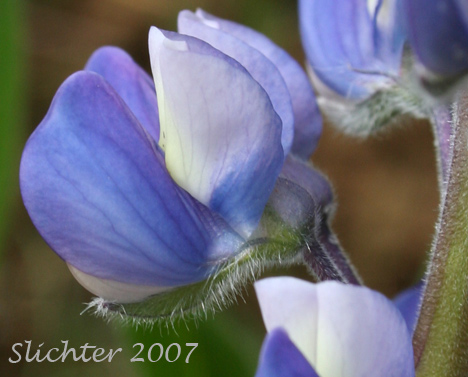Note: Currently (fall 2022), this is considered as Lupinus latifolius var. latifolius in Washington.
 The
photo at right shows a close-up of the flower of Columbia Gorge broad-leaf lupine
as seen on slopes near the confluence of the Klickitat and Little Klickitat Rivers in Klickitat County, south-central Washington........April 24, 2006.
The
photo at right shows a close-up of the flower of Columbia Gorge broad-leaf lupine
as seen on slopes near the confluence of the Klickitat and Little Klickitat Rivers in Klickitat County, south-central Washington........April 24, 2006.
The USDA website currently has this lupine classified as silky lupine, Lupinus sericeus ssp. sericeus var. thompsonianus. The Oregon Flora Project currently lists it as a hybrid, Lupinus latifolius x sericeus. Sadly, this currently is a lupine which changes its species status on a fairly regular basis the past few years.
Broad-leaf lupine is an attractive perennial with erect stems up to 1 meter in height, varying with variety from sparsely haired to heavily haired. The stems typically have 6-8 leaves with the lower leaves having petioles 2-3 times longer than the blade. The lower leaves tend to persist through flowering time. The petioles of the upper leaves range from 1-2 times longer than the blades. The 7-9 leaflets are elliptic to obovate in shape and each ranges from 3-6 cm long and 10-20 mm wide. The upper leaf surface tends to be less haired than the lower surface.
The inflorescence consists of several showy racemes from 10-20 cm long. the thin flower pedicels range from 4-9 mm long. The flowers range from light blue to bluish or lavender, or may be marked with bright violet. The flowers range from 12-15 mm long. The back of the banner lacks hairs and is distinctly well reflexed backwards from the wings and keel (Index = 15-30.) The wings lack hairs and completely cover the curved keel.The calyx is silky to shaggy-haired and lacks a spur or sac. The upper calyx lip is shallowly double-toothed. The seed pods range from 2-3 cm long and average 8 mm wide.
Columbia Gorge Lupine: var. thompsonianus - Plants of low-mid elevation in the eastern Columbia River Gorge and Klickitat River drainage. Plants covered with whitish to reddish hairs on the calyx, within the inflorescence, and often on the leaves and stems. The keel is nonciliate. Columbia Gorge broad-leaf lupine is often well over 25 cm tall.
Subalpine Lupine: L. arcticus ssp. subalpinus (formerly var. subalpinus) - Plants of alpine and subalpine ridges and meadows from Alaska south to the Cascade Mts. Plants covered with whitish to reddish hairs on the calyx, within the inflorescence, and often on the leaves and stems. The keel is ciliate and plants tend to range from 10-25 cm in height.
Broadleaf Lupine: L. latifolius ssp. latifolius (formerly var. latifolius) - Plants of open meadows and grasslands or open woods from the coast to open montane slopes, mostly west of the Cascades from southern British Columbia south to the Sierra Nevada of California. Plants covered with straight, appressed hairs all pointing the same direction. Common broad-leaf lupine is usually over 25 cm tall.
Broadleaf Lupine: ssp. viridifolius - Plants of the Siskiyous, central and southern Oregon Cascades and eastwards into Klamath and Lake Counties of south-central Oregon.
Columbia Gorge broad-leaf lupine may be found on grasslands and open oak and ponderosa pine woods.
Columbia Gorge broad-leaf lupine is endemic to the Columbia River Gorge. The species as a whole may be found from the Cascade Mts. to the coast from Alaska south to California.
In the Columbia River Gorge, it may be found between the elevations of 100'-2200' from the White Salmon River east to east of Biggs, OR.